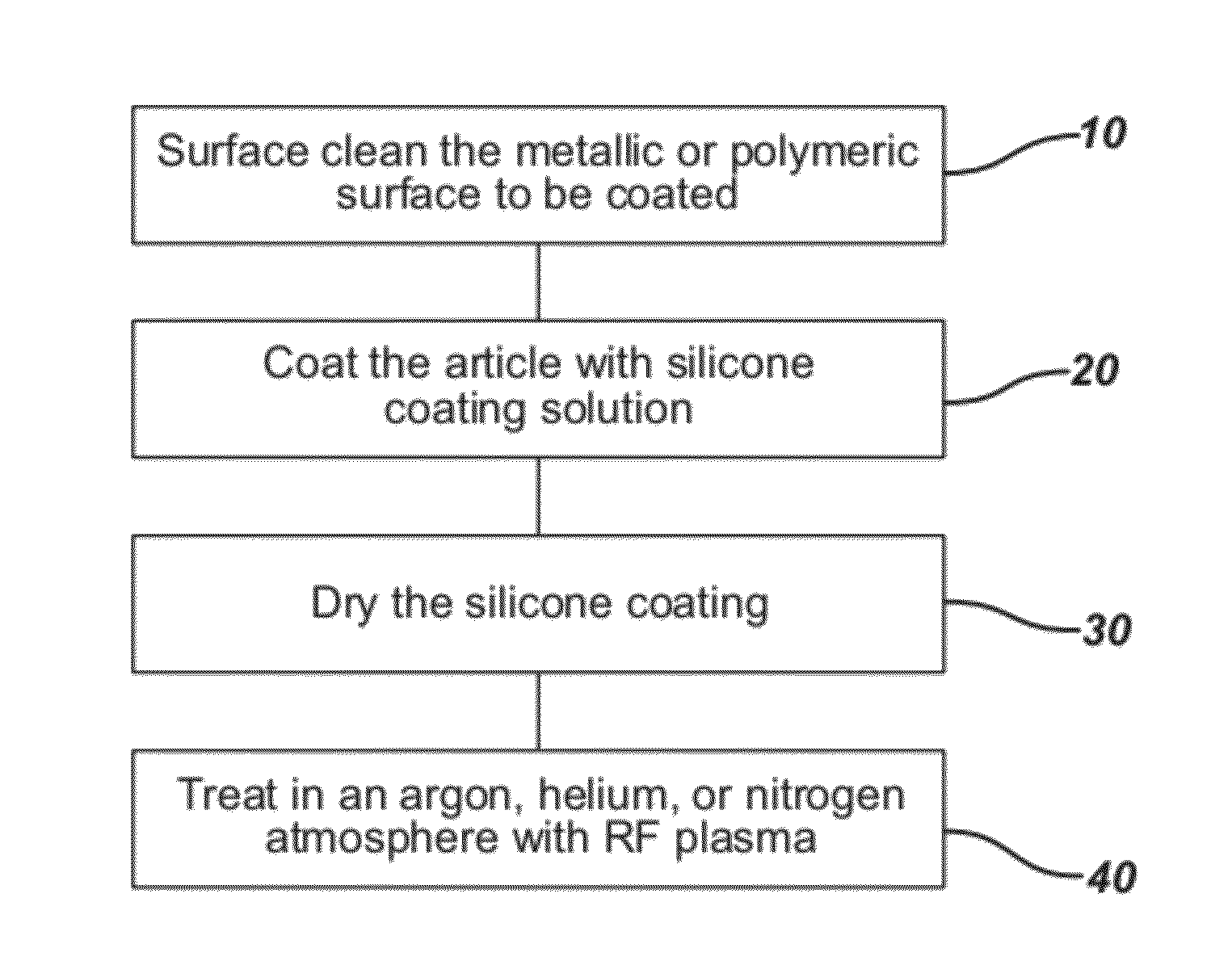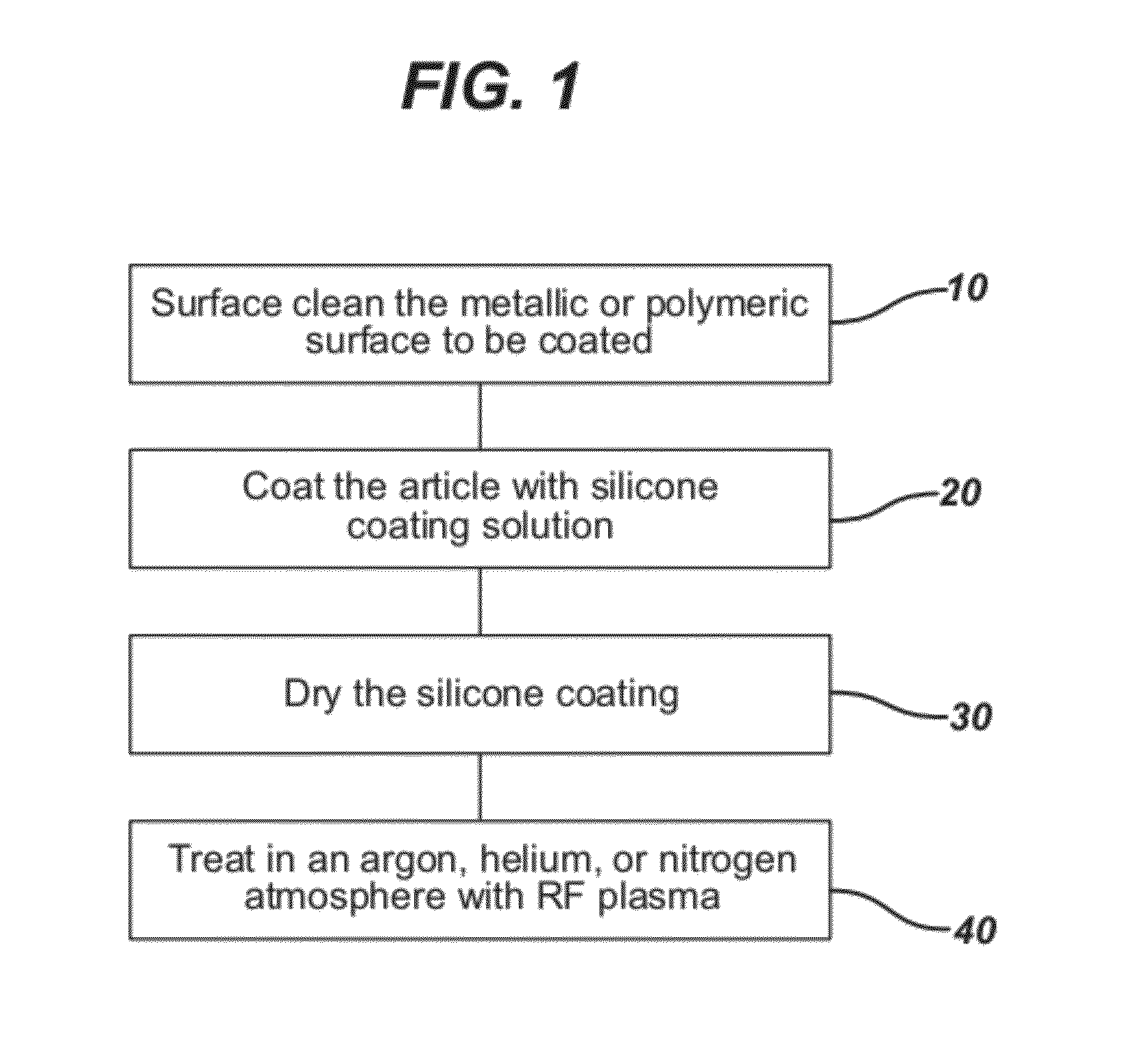Process for in situ plasma polymerization of silicone coatings for surgical needles
a technology of silicone coating and in situ plasma, which is applied in the field of curing coatings, can solve the problems of inability to predict the curing outcome, lack of uniform thermal field, and several deficiencies of the existing curing process,
- Summary
- Abstract
- Description
- Claims
- Application Information
AI Technical Summary
Benefits of technology
Problems solved by technology
Method used
Image
Examples
example 1
Preparation of the Coating Solution
[0053]A commercially available stock solution (obtained from NuSil Silicones Corp., MED1 4162) containing between 23-30 wt. % of total solids, which are silicone polymers, including 2-6 wt. % of the cross-linking agent (methylhydrogen PDMS) with the balance of the total weight being xylene was transferred into a suitable mixing vessel and diluted with Exxon Isopar K isoparrafinic hydrocarbon to obtain a working solution containing approximately by weight 6% hydroxy-terminated polydimethylsiloxane, up to 1.2 wt. % methylhydrogen siloxane, about 15 wt. % xylene, and about 77.8 wt. % Exxon Isopar K isoparrafinic hydrocarbon. Mixing was performed using a high shear mixer (Cowles) for about 10 minutes at room temperature. The coating solution did not contain any catalyst. The working solution was then used to dip coat surgical needles as described in Example 2.
example 2
[0054]Straight, taper point stainless steel needles (23 mils in diameter) were obtained from a conventional surgical needle manufacturing process. The needles were degreased by plasma cleaning in a typical tetrafluoromethane / oxygen plasma. The plasma was run at about 100 W using a commercially available plasma treatment system, specifically Plasma Technology System, Model # PS0150, RF Chamber having a 500 Watt RF power source; the system had three mass flow controllers. The make-up gas used was 60% by volume tertafluoromethane and 40% oxygen as a gas atmosphere at about 0.05 torr for about 30 minutes. The needles were clamped in a conventional needle holder individually at the base of each needle. The needles then were dip coated by immersing the needles once into a conventional 1 liter dip tank containing the working solution, as described in Example 1, for several seconds. The needles were then lifted up and out from the tank and placed with their tips facing upward in ...
example 3
Plasma Curing
[0055]Plasma curing was performed utilizing a commercially available plasma treatment system, specifically Plasma Technology System, Model # PS0150, RF Chamber having a 500 Watt RF power source; the system had three mass flow controllers. The coated needles with coatings applied by a dipping process as described in Example 2 were positioned using the holding block needle-holder into the RF chamber. Vacuum was then applied to establish a base pressure of about 0.01 ton. Helium purge gas flow was established at 20-50 cc / min. RF power was then applied at 450 watts, and vacuum in the chamber was maintained at 30-40 mTorr, and the frequency was 13.56 MHz unmodulated. After 30 minutes of treatment, the chamber was brought to atmospheric pressure, and the needles removed from the chamber for testing. The coatings were tack-free when removed. It was also observed that the silicone coatings were completely cured, that is, polymerized as evidenced by a lack of tackiness.
PUM
 Login to View More
Login to View More Abstract
Description
Claims
Application Information
 Login to View More
Login to View More - R&D
- Intellectual Property
- Life Sciences
- Materials
- Tech Scout
- Unparalleled Data Quality
- Higher Quality Content
- 60% Fewer Hallucinations
Browse by: Latest US Patents, China's latest patents, Technical Efficacy Thesaurus, Application Domain, Technology Topic, Popular Technical Reports.
© 2025 PatSnap. All rights reserved.Legal|Privacy policy|Modern Slavery Act Transparency Statement|Sitemap|About US| Contact US: help@patsnap.com



